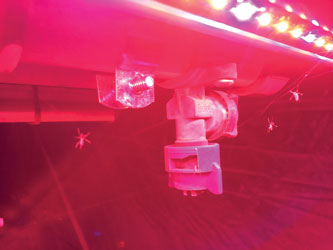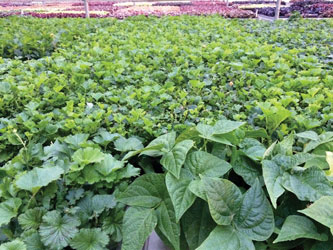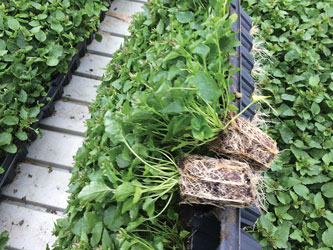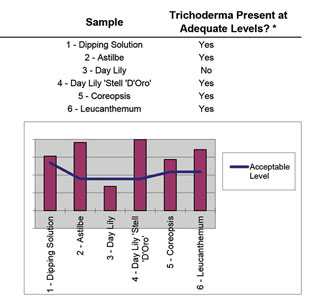6/30/2017
The Little Things Make All the Difference
Roger McGaughey

When I was growing up in Northern Ireland we had some neighbors, a family called the Littles. There was a saying in the neighborhood: “Every Little does a little, every Little helps a little and every little helps.”
This is so true in all walks of life, especially with respect to workplace teamwork and job preparation. If we take care of the little things, the important details, the big things, often take care of themselves and everyone’s stress level can be lower. This is vitally important in the greenhouse in spring—especially in a year like this when spring was very late, with the result that our growing season was condensed but the end date remained the same.
The following thoughts are just a number of little facts and reflections from the last few months:
Figure 1. Adults Aphidoletes flying around the lights and hanging onto webs that they’d made on the watering boom.
• Pest control in our biological world is always a very important issue. A new venture for us this year was an attempt to rear a population of Aphidoletes that would assist with aphid control. Last year, we used BCA cardboard tubes as breeding areas. This year, following discussions with Ron Valentin (Bioline), we tried breeding boxes containing window screening and some moist coir to provide humidity. We placed the boxes on a table in our secondary prop area where we had the right temperature environment. We also installed some LED lamps on a watering boom above this table. As Aphidoletes are a nocturnal insect, we extended the day with the LED lights and hoped for successful results. Some interesting observations were made.
Over

all, we didn’t manage to establish a population in the breeder boxes, but
Aphidoletes larvae were found on some aphid banker plants we had on the tables as a food source. One evening after dark, I saw some adults flying around the lights and hanging onto webs that they’d made on the watering boom (Figure 1). Seeing is believing. It’s important to take a little time to look at your crops to see what you can find and determine if a new experiment is working.
Figure 2. LED lights were very effective for the production of bean banker plants.
• The LED lamps were also extremely useful in the winter production of lobularia and peppers for the establishment of an early
Orius population (thrips control) and the lights were very effective for the production of bean banker plants, which we use for red spider monitoring. In the past, our bean plants have been very leggy and have really been too large to use properly on our plug tray tables. We’ve tried, unsuccessfully, some assorted PGRs, but based on information from industry friends, we settled on Dazide applications, starting when the plants were quite small. Those sprays, coupled with the LED lamps, produced squat plants with large leaves, ideal for scouting needs (Figure 2).
• In th

e past, we started our spider control by introducing Phytoseiulus in our secondary prop area. However, after asking around and seeking help from industry BCA specialists, we’re achieving additional spider control by introducing
Phytoseiulus earlier in our propagation process. These insects seem to happily start working in our prop fog environment when introduced just after we stick our spider-sensitive cuttings. To date this year, we’ve not had to spray any red spider control chemicals. This is quite an achievement and a tremendous labor-saving situation.
Figure 3. If we can increase the quality of our root systems, then our plugs will be healthier.
• Speaking of our prop fog system, we’re making environmental improvements here also. Following my last article in March, I got an email out of the blue from my friend Royal Heins asking why the shade curtain was partly closed in one of the photos that I’d used. (Royal always asks questions about the little details). So that got me thinking ... light is obviously very important and if, by adjusting some other factors in the environment, we can get more light into our unrooted cuttings, then the speed of rooting would increase and the quality would improve. I’m now in the process of working with our propagation manager and a contact at Argus controls to configure new ways to improve our propagation environment. It’s all in the little details. Improved rooting equals less shrink. Crops this spring are better than ever.
• I’ve always been a white root kind of a guy and we’re trying to make improvements there also. As the seasons go by, we learn something new all the time. Change for the better is always good. If we can increase the quality of our root systems, then our plugs will be healthier, they’ll be more efficient in nutrient uptake, and consequently, our customers will be happier. Some current production alterations are showing exciting, positive results and we believe that going forward we’ll be able to produce an even better product (Figure 3).

Figure 4. Roger’s health report from BioWorks.
• Monitoring progress and paying attention to the little details along the way is absolutely imperative. As any good grower knows, you need to be hands on, a lot of the time constantly checking the root systems of your crops. I’ve spoken many times in the past about my appreciation for the benefits of a RootShield Plus wettable powder application right at the start of the growing process. This, in most cases, can eliminate the use of chemical root treatments throughout the crop growing cycle and avoid time-consuming REI constraints. I regularly send plant samples to the laboratory at BioWorks, the suppliers of RootShield, to get a health report on the beneficial Trichoderma levels in our crops (Figure 4).
Plugs and field-grown bare root crops—both with healthy, biological white root systems—will ultimately lead to happy and satisfied customers.
GT
Roger McGaughey, head grower at Pioneer Gardens in Deerfield, Massachusetts, was educated in Northern Ireland and England and has 44 years experience as a grower.